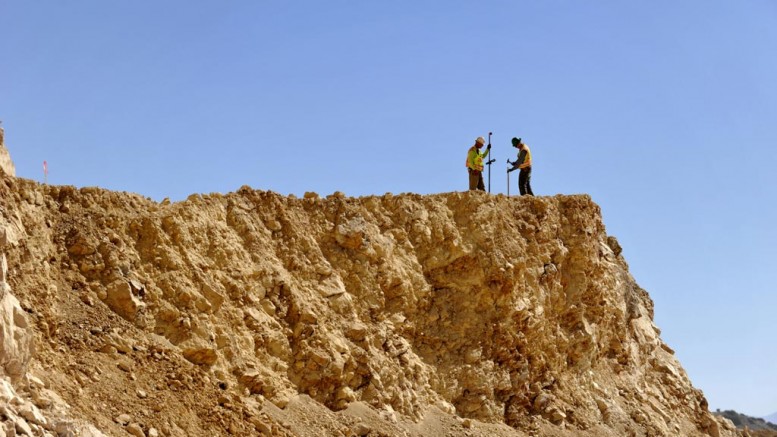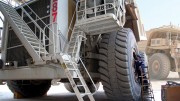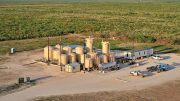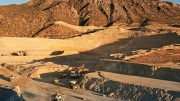U.S. firms have been atop the industry pursuing precious metals across the globe.The Northern Miner presents its top-10 list of U.S.-based, mid-tier and junior precious metals companies.
1. Coeur Mining
Market cap: US$1.3 billion
Coeur Mining (NYSE: CDE) is a diversified precious metals producer and owns the silver-gold complex of mines in Chihuahua, Mexico; the Rochester open-pit silver-gold mine in Nevada; the Kensington underground gold-silver mine in South Dakota; and the Silvertip silver-lead-zinc underground mine in British Columbia, Canada. In addition, it owns the La Preciosa silver and gold project in Durango, Mexico, and the Sterling gold project in Nevada.
Last year the Chicago-headquartered company produced a total of 12.9 million oz. silver, 367,728 oz. gold, 6.8 million lb. zinc and 3.9 million lb. lead, or 35.6 million equivalent oz. silver. In May 2019, the company provided production guidance for the year of 334,000 to 372,000 oz. gold, 12.2 million to 14.7 million oz. silver, 5.3 million lb. zinc, and 5.2 million lb. lead.
2. Hecla Mining
Market cap: US$811 million

Underground mining at Hecla’s Lucky Friday operation in Idaho. Credit: Hecla Mining.
Hecla Mining (NYSE: HL) was founded in 1891 in the Coeur d’Alene mining district of Idaho’s Silver Valley, one of the largest silver-producing districts in the world. Today the low-cost silver producer has mines in the U.S., Canada and Mexico. It owns the Greens Creek mine in Alaska — one of the largest and lowest-cost primary silver mines in the world; the Lucky Friday underground silver-lead-zinc mine in Idaho; the San Sebastian underground gold-silver mine in Mexico; the Casa Berardi underground gold mine in Quebec; and the Fire Creek and Hollister mines in Nevada. It also owns several exploration properties in North America.
Last year, the company produced a total of 10.4 million oz. silver and 262,103 oz. gold. At the end of 2018, Hecla reported proven and probable reserves of 191 million oz. silver and 2.9 million oz. gold — the highest in the company’s history. It also has proven and probable zinc reserves of 932,000 tonnes, and 774,000 tonnes of lead reserves.
The company had cash and equivalents and short-term investments of US$10 million as of June 30.
3. Argonaut Gold
Market cap: US$371 million

Argonaut Gold’s El Castillo gold mine in Mexico. Credit: Argonaut Gold.
Argonaut Gold (TSX: AR) is a Canadian gold company with assets that include the El Castillo mine and San Agustin open-pit mines, which together make up the El Castillo Complex in Durango, Mexico, and the La Colorada open-pit, gold-silver mine in Sonora, Mexico. It also owns the advanced exploration-stage San Antonio project in Baja California Sur, Mexico; the Cerro del Gallo open-pit, gold-silver-copper project in Guanajuato, Mexico; and the Magino open-pit gold project in Ontario, Canada, which received federal government approval of its environmental assessment in January 2019. It also has several exploration-stage projects in North America.
Last year, the company produced 165,117 equivalent oz. gold at US$792 per oz. gold cash costs sold, and US$912 per oz. gold all-in sustaining costs sold. This year management expects to produce 200,000 to 215,000 equivalent oz. gold at between US$775 and US$875 per oz. gold cash costs sold, and between US$875 and US$975 per oz. gold all-in sustaining costs sold.
The company plans to invest US$50 million to US$60 million in capital expenses this year. The largest one-time budgeted capital item is US$15 million, for expansion of the crushing and leaching facilities at the San Agustin mine to increase capacity from 20,000 tonnes per day to 30,000 tonnes per day.
4. Gold Resource Corporation
Market cap: US$202 million
Gold Resource (NYSE-AM: GORO) is a gold and silver producer, developer and explorer, with operations in Mexico and the United States. The company poured first gold at its Isabella Pearl mine in Nevada in the second quarter of this year — just 10 months after breaking ground on the project in the Walker Lane belt.
The company owns several assets in Oaxaca, Mexico, including the Arista underground mine, the Aguila mill and the Mirador underground mine. Initial production at Arista began in March 2011, and mineralized material from the mine is trucked 2 km to the Aguila mill, where it is processed into three concentrates: copper-gold, lead-silver and zinc. The Mirador mine, also in Oaxaca state, is part of the company’s Alta Gracia project.
Gold Resource produced a total of 9,559 oz. gold and 467,484 oz. silver in the year’s second quarter, which along with base metal revenue generated US$29.4 million in net revenue and US$1.8 million — or US3¢ per share — in net income during the three months ended June 30.
5. Gold Reserve
Market Cap: US$176 million

An artisanal miner excavation site at Gold Reserve’s 45%-owned Siembra Minera gold-copper project in Venezuela. Credit: Gold Reserve.
Gold Reserve (TSXV: GRZ; US-OTC: GDRZF) owns 45% of the Siembra Minera gold-copper-silver project in the Km 88 gold-mining district of Venezuela’s Bolivar state. (The Venezuelan government owns a 55% interest.) Gold Reserve has spent more than US$10 million on the project since August 2016, and the next phase of development is expected to include detailed design work for the small cyanidation plant and related facilities, and metallurgical tests. Depending on financing, the company also expects to start a feasibility study on a large flotation plant.
In 1992, the company began developing the Brisas gold and copper project, also in Venezuela’s Km 88 mining district, and invested close to US$300 million in the project. But in April 2008, the government revoked previous authorization to proceed with construction, and in 2009 the company sent the case to international arbitration. In June 2017, the company signed a settlement agreement with Venezuela, under which the government agreed to pay the company a total of US$1.03 billion. As of March 2019, the company had received US$276 million from the settlement, leaving US$756 million outstanding.
6. Vista Gold
Market cap: US$95 million

Vista Gold Corp.’s Mt Todd gold project in Australia’s Northern Territory. Photo credit: Vista Gold Corp.
Vista Gold (TSX: VGZ; NYSE-AM: VGZ) owns the Mt Todd gold project in Australia’s Northern Territory, 250 km southeast of Darwin. The project is the largest undeveloped gold project in the country. Vista has invested over US$100 million to advance Mt Todd since acquiring the project in 2006.
An updated preliminary feasibility study on the brownfield project released in January 2018 envisions a large, conventional open-pit operation, with a 13-year mine life. The mine is expected to produce 382,211 oz. gold each year over its mine life, with an average of 479,450 oz. gold a year during the first five years of operation. Initial capex was pegged at US$839 million, and the mine should deliver a US$679-million after-tax net present value at a 5% discount rate, and a 20.5% after-tax internal rate of return at a gold price of US$1,300 per ounce. Life-of-mine average cash costs were estimated at US$645 per oz., with average cash costs of US$571 per oz. during the first five years of operations.
Mt Todd has proven and probable reserves of 221 million tonnes grading 0.82 gram gold per tonne at a cut-off grade of 0.40 gram gold, for 5.85 million contained oz. gold.
7. Sandspring Resources
Market cap: US$47 million

A driller at Sandspring Resources’ Toroparu gold project in Guyana. Credit: Sandspring Resources.
Sandspring Resources (TSXV: SSP; US-OTC: SSPXF) is developing its Toroparu gold project in western Guyana, 50 km from Guyana Goldfields’ Aurora gold mine. A preliminary economic assessment (PEA) in June 2019 estimated Toroparu would produce 4.5 million oz. gold — 3.64 million oz. of which would come in the form of gold doré bars — over a 24-year mine life. In addition, the project would produce 4.46 million payable oz. silver and 124.7 million payable lb. copper over the mine life. During the first 10 years, the mine would produce 1.48 million oz. gold doré. In the second, 14-year phase, it would produce 2.15 million oz. gold doré and another 876,000 oz. gold-in-concentrate. The study estimates all-in sustaining costs would run to US$812 per oz. over the mine life. Pre-production capex was pegged at US$378 million. Sandspring says it plans to complete a final feasibility before year-end.
In November 2013, Wheaton Precious Metals signed a gold-purchase agreement, and in 2015, added a silver by-product stream to the agreement. Frank Giustra’s Fiore Group came in during 2015, and now owns 9.3% of the company’s stock, and last year, Gran Colombia Gold became a shareholder with 16.7% equity, which increased to 19.96% after Sandspring’s $4-million private placement in June.
8. Fiore Gold
Market cap: US$39 million

A haul truck placing ore on the leach pad at Fiore Gold’s Pan gold mine in Nevada. Credit: Fiore Gold.
Americas-focused Fiore Gold (TSXV: F; US-OTC: FIOGF) has assets in Nevada and Chile. Its North American assets include the producing Pan mine near Eureka, Nev., and the nearby Gold Rock exploration project. Fiore also controls the Golden Eagle exploration project in Washington State, 10 km from Kinross’ Kettle River mill.
In Chile, Fiore controls a land package next to Yamana’s flagship El Penon mine in the Atacama region. Fiore’s Pampas el Penon properties lie west, south and north of the northernmost portion of Yamana’s El Penon deposit, and its Cerro Tostado project is south of the Mina Fortuna satellite deposit and the main El Penon mine and mill complex.
The company’s initial goal is to become a 150,000 oz. per year gold producer. In 2018, the company produced 34,297 oz. gold at cash costs of US$820 per oz., and all-in sustaining costs of US$1,063 per ounce.
9. Santa Fe Gold
Market cap: US$32 million
Santa Fe Gold (US-OTC: SFEG) started mining operations at its Jim Crow gold-silver mine in the historic Steeple Rock mining district of southwestern New Mexico at the end of April 2019. Initial production at the mine is planned to be stockpiled at surface in preparation for shipment to smelters in Arizona.
The company hopes production from the Jim Crow mine will generate funds to finance development of its other mines in the district — the adjacent Imperial mine and the Bilalli mine, 6.4 km north of Jim Crow. It plans to have all three mines in production over the next 12 to 18 months.
In addition to its three past-producing mines in Steeple Rock, Santa Fe Gold has acquired five other historic silver mines: the Alhambra, Black Hawk, Silver King, Good Hope and Bullard’s Peak mines. These are covered by 13 patented claims and 82 unpatented claims in the Black Hawk district in Grant County, 24 km southwest of Silver City, in New Mexico. Santa Fe is reviewing development options for the assets.
10. Paramount Gold Nevada
Market cap: US$25 million
Paramount Gold Nevada (NYSE-AM: PZG) owns the Grassy Mountain gold project in eastern Oregon, 113 km west of Boise, Idaho, and the Sleeper gold project in northern Nevada, 40 km northwest of the town of Winnemucca.
The company completed a prefeasibility study on Grassy Mountain last year that outlined annual production of 47,000 oz. gold and 50,000 oz. silver over a 7.25-year mine life, at cash-operating costs of US$528 per oz. gold. The study estimated initial capex of US$110 million for a 750-tonne-per-day mine and milling operation, and a 2.5-year payback period. The study anticipates a US$87.7-million, after-tax net present value — at a 5% discount rate — and a 28% after-tax internal rate of return. The company launched a feasibility study in June 2019, and says it plans to start construction as soon as it receives all of the required permits, which it forecasts will be in 2020.
AMAX Gold operated the Sleeper mine from 1986 until 1996, and produced 1.7 million oz. gold and 2.3 million oz. silver. A PEA of Sleeper in 2015 proposed a 30,000-tonne-per-day, heap-leach-only operation, with a low strip ratio and 3.5-year payback period of US$175 million in initial capital expenses. The PEA envisioned annual production of 102,000 oz. gold and 105,000 oz. silver at cash-operating costs of US$529 per equivalent oz. gold produced.
In April 2019, Paramount closed a 2% net smelter return royalty agreement for US$2 million with Franco-Nevada. The proceeds will help advance permitting efforts and the feasibility study on Grassy Mountain.





Fantastic news to see that Santa Fe Gold Corp.
made this list !!!